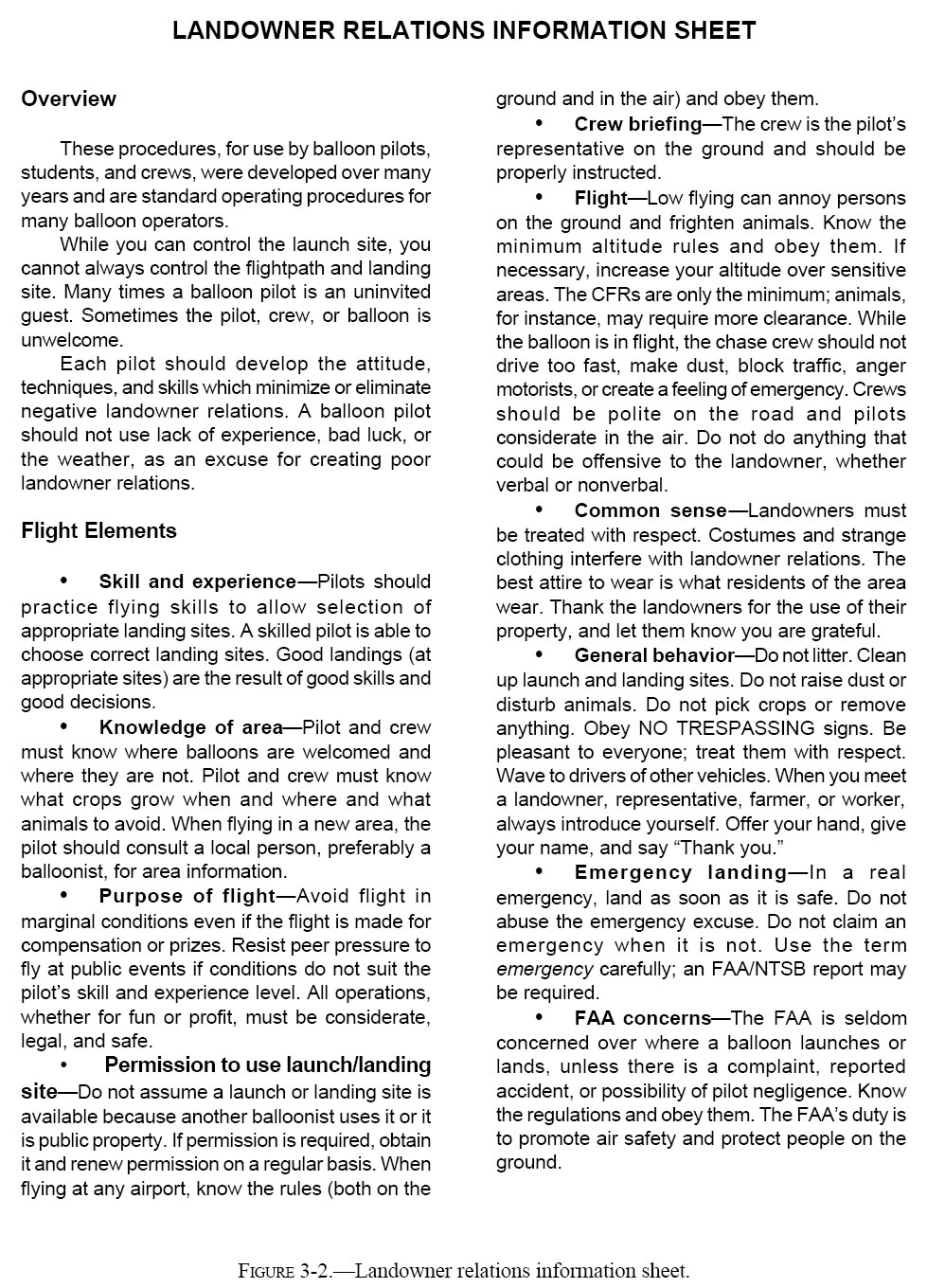Crew Responsibilities
The policy regarding expectations of crew help at
landing is—if you cannot land the balloon without
help, you should not be flying. It is not always possible
for the chase crew to be at the landing site, so plan to
land without assistance.
If the crew is at the landing site and clearly able to
render assistance, you have options. Have the crew
pull the balloon across a field to the road while it is
still inflated or gently lead the inflated balloon away
from any possible obstacles.
The crew is of no help in a windy landing. Crew will
only be of assistance after the basket has stopped
moving. There is a possibility of people on the ground
being injured while trying to assist with a windy
landing—even a moderately windy landing.
Remember that a 77,000 cubic foot balloon has a
momentum weight of several tons. Do not ever get in
front of a moving balloon basket.
Deploying a drop line is useful only if the crew is
strong, healthy, trained, and wearing gloves. Rarely
should a pilot ask a stranger for assistance during
landing. Use great care with a drop line, or handling
line and use only in very light or calm winds.
Injuries in ballooning are few, and most happen during
landing. If you are carrying passengers, your goal is
to provide them with the gentlest landing possible in
the best possible site. When flying alone, practice
landings so you know how to control your balloon at
the end of the flight.
Maintaining Good Relations With Landowners
The greatest threat to the continued growth of
ballooning is poor landowner relations. The emphasis
should be to create and maintain good relations with
those who own and work the land that balloonists fly
over and land on. Balloon pilots must never forget that at most landing sites, they are unexpected visitors.
An assuming balloonist may think the uninvited visit
of a balloon is a great gift to individuals on the ground.
The balloon pilot may not know the difference
between a valuable farm crop and uncultivated land.
A balloonist may not notice the grazing cattle. A chase
vehicle driver may drive fast down a dirt road raising
unnecessary dust. A crewmember may trample a
valuable crop.
There are several situations where a balloon pilot or
crew may anger the public. When people are angered,
they demand action from the local police, county
sheriff, FAA, or an attorney. The FAA does not initiate
an investigation without a complaint. The balloonist
is the one who initiates the landowner relation’s
problem.
How can balloonists ease the effect they have on
people on the ground? First, develop your skills to
allow yourself the widest possible choices of landing
sites. If you fly in farmland, as many balloonists do,
wear what is customary for the area. Make sure your
crew is trained to respect the land, obey traffic laws,
and be polite to everyone they come in contact with.
The crew should always get permission for the balloon
to land and the chase vehicle to enter private property.
You should learn the trespass laws of your home area.
You should be able to find them at the library. In some
states, it is very difficult for the balloon pilot and
passengers to trespass, but very easy for the chase
vehicle and crew to trespass.
If you land on the wrong side of a locked gate or fence,
the first thing your chase crew should do is try to find
the landowner or resident to get permission to enter.
If no one can be found, it may be necessary to carry
the balloon and lift it over the fence.
Do not cut or knock down fences, as it will probably
be considered trespassing. In some places, even the
possession of fence-cutting and fence-repairing
tools may be interpreted as possession of burglary
tools, creating liabilities. Pilot and crew should
have a clear understanding of what is acceptable
and what is not acceptable.
Sometimes local law enforcement people will
arrive at the scene of a balloon-landing site.
Someone may have called them or they may have
seen the balloon in the air. They may just be
interested in watching the balloon (which is usually
the case), or they may think a legal violation has
occurred. If law enforcement people approach you,
always be polite. They probably do not know much
about federal law regarding aviation. However,
even if they are wrong and you know they are
wrong, there is no point in antagonizing them with
a belligerent attitude. It is better to listen than to
end up in court.
Chase crews should always be friendly to farm
workers and other local workers. The person you
waved to last week may be the tractor driver who pulls your chase vehicle out of a muddy rut next
week.
Figure 3-2 is suggested information pilots should
give to all crewmembers titled, Landowner
Relations Information Sheet. Keep copies in your
chase vehicle and go over them with all
crewmembers, including pickup crew at events.
One of your most important concerns is landowner
relations. The continued availability of balloon
landing sites depends on good landowner and
public relations. Constant vigilance by balloon
pilots and crews to do no harm to the land and be
considerate of people and property on the ground
is a must.

|

